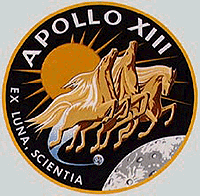EXPLORATION - What has gone before...
Apollo 13 page1
On April 11, 1970 Apollo 13 lifted off from the Cape. Shortly after the command module docked with the lunar module they broke Earth orbit and entered into "trans-lunar insertion" (a path to the Moon with no immediate way to return to Earth). At 55 hours 52 minutes into the mission and nearly 200,000 miles from Earth Capcom told astronaut Swigert to stir the cyro tanks. Less than two minutes later the astronauts reported a loud bang and Swigert reported to Houston "...we've had a problem here." Confusion, concern and determination ensued as gages reported unexpected drops and spikes. All that could be seen from the command module window was some debris and liquid trails. A series of outages and problems had to be addressed and the Lunar Module was used for something never tried...a lifeboat. Sustaining the astronauts' lives was paramount and they only had four days...and that was if they could maneuver the spacecraft into a proper path to sling it back to the Earth from the Moon.
The movie "Apollo 13" - although "Hollywood" - was very close to all the events. I salute the crew of Apollo 13 and all the personnel that enabled their safe return.
This plaque is located in the outside Saturn-V display of the Davidson Center for Space Exploration at the Space & Rocket Center, Huntsville, Alabama...it reads:
LOVELL - SWIGERT - HAISE
Launched: April 11, 1970 - Splashdown: April 17, 1970
"OKAY HOUSTON. HEY, WE'VE GOT A PROBLEM HERE..."
Commander Jim Lovell's words initiated heroic efforts by crew and mission control to salvage a crippled spacecraft and return Apollo 13 safely to Earth. The Apollo 13 mission is the only Apollo flight remembered primarily for the effort to bring it home. On the second day of the flight, a power-producing oxygen tank exploded, badly damaging the service module and forcing the Moon landing to be aborted. But with the spacecraft nearly dead, the cancellation quickly paled in importance to the need to save the astronauts. As mission control radioed emergency strategies around the clock, the astronauts converted the lunar module into a "lifeboat" and overcame each crisis by jury-
rigging damaged equipment with the meager resources onboard. Following an anxious pass behind the Moon to gain lunar "sling-shot" momentum for the long journey back to the Earth, Apollo 13 limped home with a worldwide television audience watching breathlessly. The astronauts' safe return, despite enormous challenges, was cause for great celebration - reason enough to label the crippled mission a "successful failure."


